#APPLE M SERIES PROCESSOR
Explore tagged Tumblr posts
Text
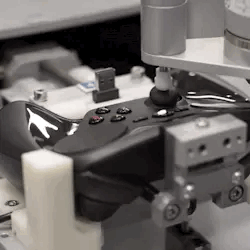


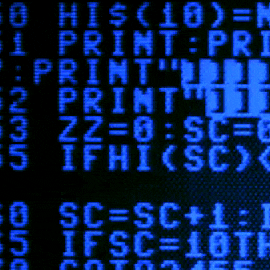
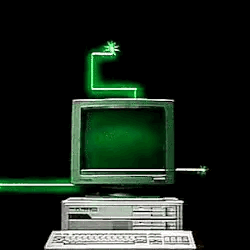


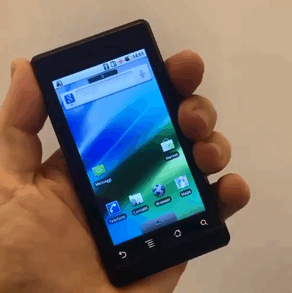


#EMAIL#EMAIL ADDRESS#FORM#SECURITY#CYBERSECURITY#XBOX#CONTROLLER#apple computer#APPLE COMPUTERS#INTEL CORE ULTRA PROCESSOR#APPLE M SERIES PROCESSOR#CODE#COMPUTER CODE#COMPUTER PROGRAMMING#ARTIFICIAL INTELLIGENCE#MACHINE LEARNING#ML#LLM#large language model#TECHNOLOGY#INTERNET#NETWORK#THE INTERNET#WIFI#WIRELESS#CELL PHONE#CELLULAR PHONE#CELLULAR TELEPHONE#SMART PHONE#xbox controller
0 notes
Text
appleiphone
#Apple’s latest iPhone release has once again created a buzz in the tech world. Known for its innovation and premium quality#Apple has introduced several new features and enhancements in this iPhone series. From design upgrades to advanced performance capabilities#the new iPhhttps://pricewhiz.pk/one is making headlines. Let's dive into what makes this new iPhone stand out.#Design and Display:#The design of the new iPhone continues Apple’s legacy of combining elegance with durability. The latest model features a sleek glass and me#giving it a premium look and feel. The Super Retina XDR OLED display offers stunning visuals with improved brightness and contrast#ensuring a vibrant and immersive experience. Available in different sizes#the new iPhone caters to various user preferences#whether you prefer a compact phone or a larger display.#Processor and Performance:#At the heart of the new iPhone is the A16 Bionic chipset#Apple’s most powerful chip to date. This 6-core CPU and 5-core GPU deliver lightning-fast performance#making multitasking#gaming#and content creation smoother than ever. With its advanced machine learning capabilities#the iPhone adapts to your usage patterns#optimizing performance and enhancing overall efficiency.#Camera System:#Apple has always excelled in mobile photography#and the new iPhone takes it a step further. The upgraded 48-megapixel primary camera captures stunningly detailed photos#even in challenging lighting conditions. Low-light photography has seen significant improvements#allowing users to take clearer#sharper images at night. The iPhone also offers advanced video capabilities#including Cinematic Mode and Pro-level editing tools#making it ideal for both amateur and professional content creators.#Battery Life and Charging:#Battery life has always been a crucial factor for iPhone users#and Apple has made improvements in this area as well. The new iPhone promises all-day battery life#ensuring that you stay connected and productive without constantly worrying about recharging. Fast charging and wireless charging options m#Software and Security:
2 notes
·
View notes
Text
Reminder that this is slowly happening with videogames and you should fight tooth and nail to keep physical carts/discs for any system you own because it's one of the few ways to guarantee you'll have a playable copy in the future if you want to go back to it or resell it. "Digital convenience" is just another bait and switch to make you dependent on the ecosystem so they can pull away the better options.
As per the terms and conditions on most online storefronts (exceptions: gog, itch) when you 'buy' a game you're buying a license to play the game for a set unknown timeframe as dictated by the storefront. This license can and will be revoked immediately if the game features a licensed music track and the developer doesn't care enough to remove it when the license lapses (or if they don't exist anymore) or for a myriad of other reasons, and I've had stuff removed from my steam library over this before.

108K notes
·
View notes
Note
If the Commodore 64 is great, where is the Commodore 65?

It sits in the pile with the rest of history's pre-production computers that never made it. It's been awhile since I went on a Commodore 65 rant...
The successor to the C64 is the C128, arguably the pinnacle of 8-bit computers. It has 3 modes: native C128 mode with 2MHz 8502, backwards compatible C64 mode, and CP/M mode using a 4MHz Z80. Dual video output in 40-column mode with sprites plus a second output in 80-column mode. Feature-rich BASIC, built in ROM monitor, numpad, 128K of RAM, and of course a SID chip. For 1985, it was one of the last hurrahs of 8-bit computing that wasn't meant to be a budget/bargain bin option.
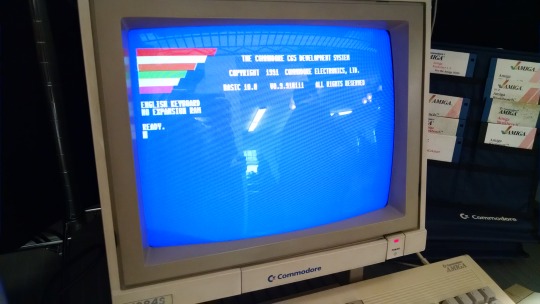
For the Amiga was taking center stage at Commodore -- the 16-bit age is here! And its initial market performance wasn't great, they were having a hard time selling its advanced capabilities. The Amiga platform took time to really build up momentum square in the face of the rising dominance of the IBM PC compatible. And the Amiga lost (don't tell the hardcore Amiga fanboys, they're still in denial).
However, before Commodore went bankrupt in '94, someone planned and designed another successor to the C64. It was supposed to be backwards compatible with C64, while also evolving on that lineage, moving to a CSG 4510 R3 at 3.54MHz (a fancy CMOS 6502 variant based on a subprocessor out of an Amiga serial port card). 128K of RAM (again) supposedly expandable to 1MB, 256X more colors, higher resolution, integrated 3½" floppy not unlike the 1581. Bitplane modes, DAT modes, Blitter modes -- all stuff that at one time was a big deal for rapid graphics operations, but nothing that an Amiga couldn't already do (if you're a C65 expert who isn't mad at me yet, feel free to correct me here).
The problem is that nobody wanted this.
Sure, Apple had released the IIgs in 1986, but that had both the backwards compatibility of an Apple II and a 16-bit 65C816 processor -- not some half-baked 6502 on gas station pills. Plus, by the time the C65 was in heavy development it was 1991. Way too late for the rapidly evolving landscape of the consumer computer market. It would be cancelled later that same year.
I realize that Commodore was also still selling the C64 well into 1994 when they closed up shop, but that was more of a desperation measure to keep cash flowing, even if it was way behind the curve by that point (remember, when the C64 was new it was a powerful, affordable machine for 1982). It was free money on an established product that was cheap to make, whereas the C65 would have been this new and expensive machine to produce and sell that would have been obsolete from the first day it hit store shelves. Never mind the dismal state of Commodore's marketing team post-Tramiel.

Internally, the guy working on the C65 was someone off in the corner who didn't work well with others while 3rd generation Amiga development was underway. The other engineers didn't have much faith in the idea.
The C65 has acquired a hype of "the machine that totally would have saved Commodore, guise!!!!1!11!!!111" -- saved nothing. If you want better what-if's from Commodore, you need to look to the C900 series UNIX machine, or the CLCD. Unlike those machines which only have a handful of surviving examples (like 3 or 4 CLCDs?), the C65 had several hundred, possibly as many as 2000 pre-production units made and sent out to software development houses. However many got out there, no software appears to have surfaced, and only a handful of complete examples of a C65 have entered the hands of collectors. Meaning if you have one, it's probably buggy and you have no software to run on it. Thus, what experience are you recapturing? Vaporware?
The myth of the C65 and what could have been persists nonetheless. I'm aware of 3 modern projects that have tried to take the throne from the Commodore 64, doing many things that sound similar to the Commodore 65.
The Foenix Retro Systems F256K:
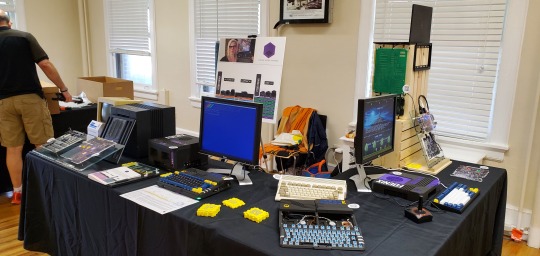
The 8-Bit Guy's Commander X16
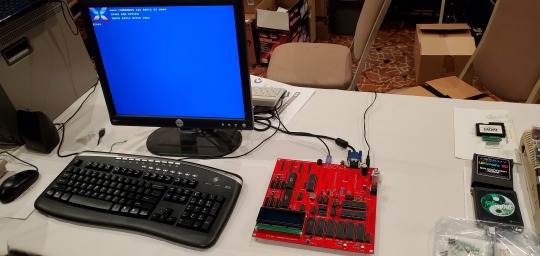
The MEGA65 (not my picture)

The last of which is an incredibly faithful open-source visual copy of the C65, where as the other projects are one-off's by dedicated individuals (and when referring to the X16, I don't mean David Murray as he's not the one doing the major design work).
I don't mean to belittle the effort people have put forth into such complicated projects, it's just not what I would have built. In 2019, I had the opportunity to meet the 8-Bit Guy and see the early X16 prototype. I didn't really see the appeal, and neither did David see the appeal of my homebrew, the Cactus.
Build your own computer, build a replica computer. I encourage you to build what you want, it can be a rewarding experience. Just remember that the C65 was probably never going to dig Commodore out of the financial hole they had dug for themselves.
262 notes
·
View notes
Text
Apple M4 Powers Up the iMac: Blazing Speed for Creatives
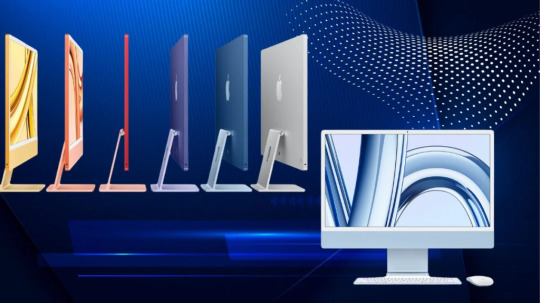
Apple M4 iMac Predictions
24 Apple iMac
Apple M4 chips may be introduced when Apple updates the 24-inch iMac in 2024. Apple intends to update the Mac series, including the iMac, with AI-focused M4 CPUs. This document details Apple’s M4 iMac ambitions.
Apple M4
Apple may incorporate the M4 chip from the latest iPad Pro models in the forthcoming 24-inch iMac. Since iMacs have M3 chips, the M4 will be a direct upgrade.
Apple M4 is a second-generation chip based on the M3’s 3-nanometer technology with performance and efficiency improvements. Apple M4 CPU outscored M3 chip by 25% in Geekbench benchmark test, suggesting considerable performance boost.
The Apple M4 had 3,695 single-core and 14,550 multi-core scores, compared to 3,087 and 11,702 for the M3.
Apple’s M4 processor has a 10-core GPU and CPU with four performance and six efficiency cores. Apple uses an M4 with a 9-core CPU in the iPad Pro, but the iMac may not have it.
Other Macs will have upgraded M4 Pro, M4 Max, and M4 Ultra CPUs, while the 24-inch iMac, which is equal in price to the MacBook Air, will only have the M4 chip.
Create
No signs suggest Apple will revamp the iMac soon the last overhaul was in 2021. The 2024 iMac refresh may focus internal improvements over exterior design changes.
Computers and displays are merged in the iMac. It fits on a desktop due to its narrow profile and 11.5mm thickness. It has a pastel chin and comes in bright shades.
They know of no iMac enhancements other than the Apple M4 chip.
Larger iMac?
Despite rumours, a 30-inch iMac was still in development in mid-2023. Its release date is unknown. As of May 25, 2024, Apple has no larger iMac. Current 24-inch iMacs include M3 chips. In 2024, rumours of a bigger iMac with an M-series CPU had faded. Apple hasn’t confirmed a 30-inch model for 2025.
Expect a larger iMac: Rumours say Apple may sell a larger iMac in the future.
Connect Mac to external display: You can add a larger external monitor to your iMac or Mac mini. This maximises screen space and lets you choose size and resolution.
Consider Mac Studio: The Mac Studio is fast and may be used with a larger display for a strong desktop arrangement.
Launch Day
Bloomberg’s Mark Gurman expected a 24-inch iMac M4 processor update “around the end of the year.” The iMac may launch at October or November Apple events with new Macs. Pre-year MacBook Pro and Mac mini improvements are anticipated. Since the iMac was updated in October 2023, an October 2024 release would conclude the year.
The M4 processor outperforms the M3 with a 10-core CPU (6 efficiency and 4 performance) and GPU. Hardware-accelerated ray tracing and 16-core Neural Engine are featured. The M4 iMac could handle video editing and 3D rendering.
Apple iMac M3
They expect the new iMac to have a 24-inch Retina 4.5K display like the M3 model. Apple may possibly offer more colours for the upcoming iMac, like the M2 model. The M4 iMac will be a major upgrade from the M3. Keep an eye out for Apple’s M4-powered iMac later this year if you want a powerful and adaptable desktop.
Based on rumours and leaks, the M4 iMac may include these features:
The next-generation 24-inch iMac is believed to have the M4 chip, which Apple used in the current iPad Pro versions.
The M4, a second-generation microprocessor with faster and more efficient performance, uses the same 3-nanometer technology as the M3.
The M4 outperformed the M3 on Geekbench by 25%. Apple’s M4 processor contains a 10-core CPU and GPU with six efficiency and four performance cores.
Design: The M4 iMac will have a slim, colourful aluminium casing like the M3.
Seven brilliant colors blue, green, pink, silver, space grey, yellow, and orange are likely.
256GB of M4 iMac storage can be expanded to 2TB of SSD storage.
The M4 iMac will have 8GB of starting memory and up to 16GB of unified memory.
Reports and leaks suggest these specs for Apple’s M4 iMac:
M4 Chip had 10 cores: 4 efficient, 6 performant.
Ten cores and second-generation 3-nanometers make the GPU more efficient and performant than M3.
24-inch 4.5K Retina screen, True Tone, P3 colour gamut.
SSDs start at 256GB and RAM up to 2TB.
Standard unified memory is 8GB, customisable to 16GB.
Dual SDXC card slots, USB-C connections, Thunderbolt 4 connectors.
From last update, there was no mention of a “M4 iMac.” Apple regularly updates their products with newer processors and features. Apple’s custom Mac CPUs are generally labelled “M”.
The M1 chip, which delivered exceptional performance and energy economy, changed Apple’s desktop and laptop computers. An M4 iMac may use this special silicon to boost power and efficiency. I prefer Apple’s official releases or trusted tech sources for the most accurate and current information.
Read more on Govindhtech.com
3 notes
·
View notes
Text
Kuo: Apple to release cheaper MacBook powered by iPhone processor
Apple’s current entry-level laptop is the , but analyst Ming-Chi Kuo believes Apple is aiming to launch an even more affordable model soon. He writes on X that Apple will go into production in late 2025 or early 2026 on a new MacBook model that will be powered by the A18 Pro chip, rather than an M-series processor. This is the same chip used in the line. The machine may feature colorful casing…
0 notes
Text
iOS Security: What it is and How to Protect Your Data

Your iPhone or iPad isn't just a communication device; it's a vault for your most personal information, from cherished photos to financial details. In a world riddled with cyber threats, the security of your mobile device is paramount. While iOS is widely lauded for its robust security features, what does that truly mean for your data, and what active steps can you take to keep it safe?
Let's delve into the layers of protection Apple builds into its ecosystem and how you can maximize your digital defenses.
Understanding iOS Security: Apple's Foundational Approach
Apple's approach to security is distinct because it controls both the hardware and software. This "full-stack" integration allows for deep-seated security measures that are difficult for other platforms to replicate.
Hardware-Software Synergy: Apple designs its chips (like the A-series and M-series) with security in mind, enabling features like the Secure Enclave to work seamlessly with the operating system.
Secure Boot Chain: Every time your iOS device starts, it performs a cryptographic check to ensure that all low-level software (from the Boot ROM to the operating system kernel) is signed by Apple. This prevents malicious or unauthorized software from loading.
Secure Enclave: This is a dedicated, isolated hardware component within Apple's chips. It handles highly sensitive data like your Face ID/Touch ID biometric information and cryptographic keys, protecting them even if the main processor is compromised. Crucially, the Secure Enclave never directly exposes your biometric data; it only confirms a match.
Data Protection (Encryption): All data on your iOS device is encrypted at rest using powerful hardware-based encryption. This means that even if your device falls into the wrong hands, your information remains unreadable without your passcode or Face ID. iCloud data is also encrypted both in transit and at rest, with options like Advanced Data Protection offering end-to-end encryption for most iCloud categories.
App Sandboxing: Each application operates in its own "sandbox," a restricted environment that limits its access to other apps' data, your personal information (like photos or contacts), or core system resources without your explicit permission. This largely prevents malicious apps from affecting other parts of your device.
App Store Review: Every app submitted to the App Store undergoes a rigorous review process to check for malware, privacy violations, and other security risks. This acts as a significant barrier against malicious software reaching your device.
Regular Updates: Apple continuously releases iOS updates that include critical security patches for newly discovered vulnerabilities. Staying updated is crucial.
Privacy Focus: Apple emphasizes user privacy through features like App Tracking Transparency (ATT) and Privacy Labels, giving users more control and visibility over how apps use their data.
Key iOS Security Features in Action (As of 2025)
Beyond the foundational architecture, iOS offers visible features that empower your security:
Face ID / Touch ID: These biometric authentication methods are not only convenient but also highly secure, leveraging the Secure Enclave to protect your identity.
Find My: This service allows you to locate your lost or stolen device, play a sound, mark it as lost (locking it and displaying a message), or even remotely erase all its data to protect your privacy.
Activation Lock: This feature links your device to your Apple ID, preventing anyone else from using or reselling your device if it's lost or stolen, even after it's been erased.
App Tracking Transparency (ATT): Introduced in iOS 14.5, ATT requires apps to ask for your permission before tracking your activity across other companies' apps and websites, giving you granular control over your data.
Safari's Intelligent Tracking Prevention: Safari works to identify and prevent cross-site tracking, limiting how advertisers and websites can follow your online activity.
Mail Privacy Protection & iCloud Private Relay: These features in Mail and iCloud+ (respectively) help hide your IP address and email activity, making it harder for senders to track your online behavior.
Lockdown Mode: For individuals facing extreme, targeted cyber threats (e.g., journalists, activists), Lockdown Mode offers an optional, extreme level of protection by severely limiting certain functionalities to minimize potential attack surfaces.
Stolen Device Protection: A newer feature that adds layers of security (like requiring Face ID/Touch ID for sensitive actions and imposing delays for certain changes) when your iPhone is away from familiar locations, even if a thief knows your passcode.
How to Protect Your Data: Practical Steps for iOS Users
While Apple provides a robust security framework, your actions are the ultimate line of defense.
Keep Your iOS Updated: This is non-negotiable. Install the latest iOS and app updates immediately. They often contain critical security patches that close vulnerabilities exploited by attackers.
Use Strong Passcodes and Biometrics: Don't rely on simple 4-digit PINs. Use a long, alphanumeric passcode (Settings > Face ID & Passcode > Change Passcode > Passcode Options > Custom Alphanumeric Code). Always enable and use Face ID or Touch ID for quick, secure unlocking.
Enable Two-Factor Authentication (2FA) for Your Apple ID: This is paramount. With 2FA, even if someone gets your Apple ID password, they can't access your account without a code sent to your trusted device or phone number. Go to Settings > Your Name > Password & Security > Two-Factor Authentication.
Review App Permissions Regularly: Periodically check which apps have access to your sensitive data (Location, Photos, Contacts, Microphone, Camera, etc.) under Settings > Privacy & Security. Grant only necessary permissions.
Be Wary of Public Wi-Fi: Public Wi-Fi networks are often unencrypted and vulnerable to snooping. Avoid conducting sensitive transactions (banking, shopping) on public Wi-Fi. Consider using a Virtual Private Network (VPN) for an encrypted connection.
Be Smart About App Downloads: Only download apps from the official App Store. Avoid sideloading apps from third-party sources or "jailbreaking" your device, as this bypasses Apple's security protections and opens you up to significant risks.
Practice Phishing Awareness: Be extremely cautious of unexpected messages, emails, or calls that ask for personal information, login credentials, or verification codes. Always verify the sender and the legitimacy of links before clicking.
Utilize "Find My" Features: Set up Find My (Settings > Your Name > Find My) so you can locate, lock, or remotely erase your device if it's lost or stolen.
Backup Securely: Back up your device regularly. If using iTunes/Finder, encrypt your backups with a strong password. iCloud backups are generally secure, especially if you have 2FA enabled and consider enabling Advanced Data Protection for iCloud (Settings > Your Name > iCloud > Advanced Data Protection).
Lock Down Safari and Other Browsers: Enable Intelligent Tracking Prevention in Safari (Settings > Safari > Privacy & Security). Consider using a privacy-focused browser if you require additional protections.
Periodically Review Privacy Settings: Apple often adds new privacy controls with iOS updates. Make a habit of checking your Settings > Privacy & Security after each major update to ensure your preferences are aligned with your comfort level.
Limitations: What iOS Can't Protect Against
While iOS provides unparalleled security, no system is 100% foolproof.
Social Engineering: No technology can prevent you from being tricked into giving away information or access if a skilled social engineer targets you.
Physical Theft (if unlocked): If your device is unlocked and falls into the wrong hands, your data is immediately vulnerable. Always keep your device locked when not in use.
Phishing/Malware (User Error): While rare, if you intentionally download a malicious profile, click a link that exploits a zero-day vulnerability (a flaw unknown to Apple), or grant extensive permissions to a rogue app, you could still be compromised.
Highly Sophisticated State-Sponsored Spyware: For extremely high-value targets, state-sponsored actors might employ incredibly sophisticated spyware (like Pegasus), often leveraging zero-day exploits. These attacks are exceedingly rare and designed to bypass even the most robust defenses, but they serve as a reminder that no system is truly impenetrable, especially against adversaries with limitless resources. This is where features like Lockdown Mode become relevant.
The Future of Your Data: A Shared Responsibility
iOS provides a formidable security foundation, designed from the ground up to protect user data and privacy. However, the ultimate responsibility for data protection rests with you, the user. By understanding iOS's core security mechanisms and consistently implementing best practices, you transform your iPhone from just a device into a truly secure personal fortress, safeguarding your digital life in an increasingly complex world. Stay informed, stay vigilant, and stay secure.
0 notes
Text
Steam for Mac Brings New Life to Apple Gaming
Introduction
Mac gaming has come a long way, and a major reason behind that progress is Steam. Once limited to PC gamers, Steam now plays a vital role in making gaming accessible to Apple users.
Using Steam for Mac today isn’t just possible—it’s a game-changer. Whether you're running a MacBook Air or a high-end iMac, Steam unlocks access to a vast library of games, features, and multiplayer tools tailored for the macOS environment.
What Makes Steam for Mac Different from Windows?
Compatibility challenges and feature limitations
Steam on macOS doesn’t support every game in the Steam library. That’s because many developers don’t build Mac versions of their titles. Moreover, some popular Steam features may behave differently or be entirely unavailable on macOS, especially with newer Apple Silicon chips.
Optimization differences between Steam for Mac and Steam for PC
The performance gap is also noticeable in some cases. While Steam for Mac is optimized for Metal graphics API and Apple hardware, it doesn’t yet match the customization and driver-level performance enhancements seen on Windows.
Installing Steam on a Mac the Right Way
Step-by-step download and installation guide
To install Steam, visit the official Steam website and download the macOS version. Open the .dmg file, drag Steam into your Applications folder, and run the app. It will automatically update itself before launching.
Setting up your Steam account for first-time users on macOS
Once installed, create a free Steam account or log in if you already have one. From there, you can access the full game store, library, and community features available in Steam for Mac.

System Requirements and Supported macOS Versions
Minimum specs for running Steam on Mac smoothly
At minimum, Steam requires macOS 10.11 (El Capitan), 1GB RAM, and an Intel or Apple Silicon processor. However, most modern games need significantly better specs at least 8GB RAM and a dedicated GPU or M-series chip.
How newer macOS updates affect Steam for Mac compatibility
Starting from macOS Catalina, Apple removed support for 32-bit apps. This affected many older Steam games. If you're using Monterey or later, be sure to check compatibility before purchasing a game.
Best Games to Play via Steam for Mac
Top-rated Steam games that run natively on Mac
Some great native titles include Stardew Valley, Civilization VI, Hades, and Total War: Warhammer II. These games are optimized for macOS and provide excellent performance.
Using Proton or Rosetta for playing non-native games
You can play non-native Windows games on Steam for Mac using workarounds like Proton (via third-party tools), Rosetta 2 for Intel apps, or emulators like CrossOver and PlayOnMac.
Using Steam Features on macOS
Accessing the Steam Overlay, Chat, and Workshop on Mac
Steam Overlay, voice chat, and the Steam Workshop are all available in Steam for Mac. However, some Workshop mods may not work if the base game isn’t Mac-compatible.
How Steam Cloud, Remote Play, and Big Picture Mode work for Mac users
Steam Cloud ensures your saves are synced between devices. Remote Play lets you stream games from another PC, and Big Picture Mode gives you a console-style interface, fully usable on macOS.
Performance Tips for Smooth Gaming
Improving game performance on MacBooks and iMacs
Keep your Mac cool, close background apps, and lower in-game resolution or effects. An external monitor and mouse can also enhance gameplay.
Recommended settings for running Steam games efficiently on Mac
Stick to medium settings, enable Metal rendering if available, and update your macOS regularly. M1/M2 chip users should prioritize games with Apple Silicon support for best results.
Alternatives and Emulators for Non-Compatible Games
Running unsupported Steam titles with Wine or Crossover
Tools like Wine, CrossOver, or Bottles help run Windows-exclusive games. They’re not perfect but work well for older or less resource-intensive games.
Using Parallels or Boot Camp for a full Windows Steam experience
Parallels Desktop lets you run Windows in a virtual machine, while Boot Camp (Intel Macs only) allows full dual-booting. Both give you access to full Windows versions of Steam.
Staying Updated and Troubleshooting Issues
Keeping Steam for Mac and your games up to date
Always run the latest version of Steam, and allow automatic game updates. This ensures compatibility with macOS security and feature updates.
Solving common Steam issues on Mac like crashes and launch errors
If Steam won’t launch or crashes, try reinstalling, clearing the download cache, or resetting app permissions in macOS System Settings. Compatibility issues are common with older games.
Conclusion
Steam for Mac has become a valuable portal for Apple gamers, offering hundreds of compatible titles and strong community support. While limitations remain compared to Windows, strategic use of tools and proper setup can unlock a fulfilling gaming experience on Mac.
With constant updates and growing developer support, Mac gamers no longer need to feel left behind. Steam brings Apple into the heart of the gaming world.
Frequently Asked Questions (FAQs)
Is Steam available for all versions of macOS? Steam supports macOS 10.11 and newer, but some games need newer versions or specific system features.
Can I run Windows-only games on Steam for Mac? Yes, tools like CrossOver, Wine, and Parallels allow Mac users to play many Windows-exclusive games.
Is Steam for Mac free to use? Yes, downloading and using Steam on Mac is completely free—just like on Windows.
Do Steam games sync between Mac and PC? Yes, Steam Cloud allows syncing progress and saves if the game supports cross-platform play.
Why isn’t a game launching on my Mac via Steam? Check for 32-bit support, verify game files, and ensure your system meets the game's requirements.
Can I use Steam controllers with Steam on Mac? Yes, most controllers including Steam, Xbox, and PlayStation controllers are compatible via Bluetooth or USB.
Does Steam for Mac support Apple Silicon natively? Many games now run natively or via Rosetta 2, and the list is expanding as developers update their titles.
1 note
·
View note
Text
Intel 14th Gen Laptops: Performance Hype or Problem-Packed Reality?
The launch of Intel 14th Gen laptops has sparked a wave of excitement in the tech world. Promising groundbreaking performance, improved efficiency, and AI-focused enhancements, these laptops are said to represent the next evolution in mobile computing. But with growing chatter about thermal issues, power consumption, and inconsistent gains, many users are now wondering—is the Intel 14th Gen hype truly justified, or is it overshadowed by underlying problems?
What’s New with Intel 14th Gen?
The Intel 14th Gen Core series, codenamed Raptor Lake Refresh, builds upon the success of its 13th Gen predecessors. While it doesn’t mark a complete architectural overhaul, Intel has made key refinements in clock speed, cache management, and AI acceleration.
Key Highlights:
Higher base and boost clock speeds for improved responsiveness
More efficient multi-core performance in some models
Support for Intel Thread Director for better task distribution on hybrid architecture
Enhanced compatibility with DDR5 memory and PCIe Gen 5 interfaces
With these upgrades, Intel claims notable improvements in gaming, content creation, and productivity tasks—making the 14th Gen laptops ideal for power users and professionals.
Real-World Performance: Does It Live Up to the Hype?
Initial benchmarks of Intel 14th Gen laptops show marginal but consistent gains in performance compared to the 13th Gen. For example, in Cinebench R23, the i9-14900HX shows a 5–8% improvement in multi-core scores. Similarly, gaming tests show smoother frame rates, particularly in CPU-bound titles.
However, the improvements aren't revolutionary. Users upgrading from 12th or 13th Gen laptops may not notice a significant leap unless they run highly demanding tasks daily. For casual users or light productivity workloads, the differences are relatively minor.
Battery Life and Thermals: The Real Concern
While performance has gone up, so has power consumption. Several reviews have noted that Intel 14th Gen laptops—especially high-end variants with i7 or i9 processors—tend to run hot and drain batteries faster.
Common Complaints Include:
Reduced battery life, sometimes by 10–20% compared to previous generations
Increased fan noise due to thermal stress
Throttling under heavy loads, which contradicts performance promises
Thermal issues appear more prominent in thin-and-light ultrabooks, where compact chassis struggle to manage the heat output. This has led to a mixed user experience, particularly for mobile professionals who rely on all-day battery life.
AI Integration and Future-Ready Features
One area where Intel 14th Gen laptops shine is AI integration. Intel’s built-in AI Boost capabilities support next-gen applications such as:
Real-time background blur and noise cancellation in video calls
AI-assisted photo and video editing
Optimized multitasking using AI-driven workload distribution
These features, while still evolving, position Intel to compete with Apple’s M-series chips and AMD’s Ryzen AI processors. However, to fully leverage these benefits, users must run software optimized for AI—a caveat that limits short-term value for the average buyer.
Value for Money: Is It Worth Upgrading?
The pricing of Intel 14th Gen laptops sits on the premium end, especially for configurations featuring i7 or i9 processors with discrete GPUs. While they offer excellent performance, the price-to-performance ratio isn't always compelling—particularly when 13th Gen or even AMD Ryzen 7000 series laptops offer comparable real-world usage at lower costs.
Best Use Cases for 14th Gen Laptops:
Gaming laptops with high refresh rate displays and powerful GPUs
Content creators who rely on CPU-intensive tasks like 4K rendering or 3D modeling
Early adopters who want future-proof features and AI performance
If you fall into these categories, an Intel 14th Gen laptop could be a solid investment. Otherwise, holding off for deeper software adoption and pricing drops might be the smarter move.
Intel 14th Gen Laptops: Final Verdict
So, is the Intel 14th Gen laptop lineup just hype, or is it truly a performance powerhouse? The answer lies somewhere in the middle.
Pros:
Noticeable performance improvements for power users
Enhanced support for DDR5, PCIe Gen 5, and AI workloads
Ideal for gaming, multitasking, and content creation
Cons:
Thermal and battery life concerns in compact models
Marginal gains over 13th Gen for general use
Premium pricing not justified for all users
For tech enthusiasts and heavy users, Intel 14th Gen delivers on most of its promises. But for the average user, it might be wise to weigh the performance gains against the added cost and potential drawbacks.
1 note
·
View note
Text

Thumb Instruction Set and Their Differences
1.nbsp;ARM Instruction Set
Bit Width: 32-bit
Purpose: Designed for high performance and full functionality.
Features:
Rich set of instructions for complex operations.
Optimized for performance in applications requiring high computational power.
Use Cases:
Early ARM processors (e.g., ARM7, ARM9).
Applications where performance is critical.
2. Thumb Instruction Set
Bit Width: 16-bit
Purpose: Designed for improved code density and lower power consumption.
Features:
Smaller instruction size reduces memory usage.
Limited functionality compared to the ARM instruction set.
Use Cases:
Embedded systems with limited memory (e.g., Cortex-M series).
Applications where power efficiency and code size are critical.
3. Thumb-2 Instruction Set
Bit Width: Mixed 16-bit and 32-bit
Purpose: Combines the advantages of ARM and Thumb instruction sets.
Features:
Provides high code density (like Thumb) and high performance (like ARM).
Allows 16-bit and 32-bit instructions to be used interchangeably.
Use Cases:
Modern ARM processors (e.g., Cortex-M, Cortex-R, and some Cortex-A).
Applications requiring a balance of performance and efficiency.
4. A64 Instruction Set
Bit Width: 64-bit
Purpose: Designed for 64-bit ARM architectures (ARMv8 and ARMv9).
Features:
Supports larger address space and enhanced performance.
Introduces new instructions for advanced computing tasks (e.g., cryptography, AI).
Use Cases:
High-performance applications (e.g., smartphones, servers, data centers).
Modern ARM processors (e.g., Cortex-A53, Cortex-A72, Apple M1/M2).
Key Differences Between ARM Instruction Sets

Summary
ARM (32-bit): High performance, used in early ARM processors.
Thumb (16-bit): High code density, used in memory-constrained systems.
Thumb-2 (16/32-bit): Balances performance and code density, used in modern embedded systems.
A64 (64-bit): Designed for 64-bit architectures, used in high-performance applications.
These instruction sets enable ARM processors to cater to a wide range of applications, from low-power embedded systems to high-performance computing platforms.
0 notes
Text
Are Apple Silicon Macs too good?

In his latest video Luke Miani asks if #Apple made their new machines too good. Across two polls, having run a second one to verify the results of the first, respondents strongly indicated they had no intention of upgrading their early M-series Macs. I have a feeling Apple fully expected that, however. Watch the video on YouTube. We have three Mini’s, two M1 and one Intel, and have no need to upgrade them anytime soon. I may desire an M4 Mini, but I don’t need one. What is behind this?
To understand this there are, I believe, two different, unrelated factors that need to be taken into consideration:
Apple’s primary drivers of revenue are the #iPhone, the App Store, and services.
There are millions upon millions of #Windows users who might choose to move to Apple rather than be forced upgrade to Windows 11 but cannot since their hardware is incompatible, because #Microsoft has chosen to enshittify their desktop with ads and #AI, or both.
Apple’s personal computer marketshare has long been around 20% with Microsoft dominating for literal decades with 72% of the PC market. But it’s critical to understand that a decade ago Microsoft had well over 80%, and it continues to slowly decay. The iPhone plays a significant role in the fact that Apple has a $2.5T valuation, as consumers tend to upgrade every two years, giving Apple a mostly reliable playing field to project consistent revenues.
NOTE: Microsoft has a similar market capitalization to Apple but the important distinction is that Microsoft engages in a wide range of markets, including corporate software and services, as well as the Xbox and video games publishing, all of which contribute to the company’s bottom line. Apple still competes by offering a mere fraction of the models and verticals of its rivals.
That consistency is crucial. It allows Apple to not only sit back and just let their Mac users be Mac users and upgrade as they please, but also breathing room for some mild experimentation with various services and hardware. The iPhone Mini was available for the iPhone 12 and 13 then cancelled to be replaced by the Plus model, which has been around longer than the Mini. And the next rumored experiment will be the iPhone Air which may appear this October. They’ve also got enough in the bank to allow them to pivot and shift based on unforeseen market fluctuations or, in the case of component availability, weather the less than stellar rollout of the moderately underwhelming M3 processor.
And Apple isn’t blind. I’m quite sure that one major consideration in their calculations is Microsoft and their recent “efforts” to tank their own success. Users are unhappy with Windows 11 and in October of this year Microsoft will be ending support for the far more popular Windows 10. Many users are even downgrading to Windows 10 to escape the oppressive changes in Windows 11. In addition, the upgrade to Windows 11 requires support for TPM 2.0 which will “relegate” millions of unsupported systems to be discarded or sold for cheap, an outcome that is exciting many nerds over the prospect of a torrent of dirt cheap or free computers which can happily and securely run #Linux and other operating systems. Linux is an easy and capable migration path, but being honest with ourselves, most Windows users won’t go this direction.
I think Apple knows this. For one, they’ve maintained a stability in offerings that is appealing when compared to Microsoft’s numerous radical shifts over the years, the frequency of which has started to turn off consumers. Second, Apple has been aggressive in allowing resellers to offer significant sale pricing and even has an exclusive deal with Walmart to sell new M1 Macbook Air base models for $700 and which is on seemingly permanent sale for $650. In most of Apple’s history this is unprecedented, as they have for decades required resellers to match their own pricing and not offer sales. Finally, Apple’s resale value for their Intel models has dropped precipitously and used M1 and M2 machines are a lot more affordable than they used to be, presenting an enticing option for budget buyers.
Apple, for the most part, has played the long game. Pixar focused on getting one particular element perfected for each film so they might add that element to their toolbox for later films like fur in Monsters Inc. and the ocean in Finding Nemo. Apple has done much the same, working on iterations of various elements of their systems, refining them until they meet their internal expectations for excellence. I don’t think it’s a coincidence that Steve Jobs ran both and had, with help from others to manifest his vision, been instrumental in forming the foundations of two entire industries. Ingest that in whatever form you prefer.
The short answer to the question posed by Luke is no. The suggestion that CEO Tim Cook and the entire team at Apple could have miscalculated that the potential longevity of their products could cause Apple, one of the wealthiest corporations on planet Earth, to disintegrate or fall into the doldrums of relevance is in itself a miscalculation of what Apple is and how it operates. Is Apple flawless? Hell no. Most recently, I think they horribly miscalculated both the retail price and consumer interest in Apple Vision. There are other failures dotting Apple’s history, as well.
On the other hand, they basically own the tablet market. Full stop. They swap first and second place with Samsung for mobile phone volume, and Samsung has to make dozens of models to compete with Apple. AirPods are stupid popular. The Apple Watch has a huge chunk of the smart watch market. Apple is doing well, and all whilst offering a fraction of the options of others they compete with.
#tech #technology #opinion
0 notes
Text
MacBook Air for under $600: 61% off deal beats Amazon price
TL;DR: When you opt for a refurbished laptop, you can get a 2020 M1 MacBook Air for $579.99. Still on a Mac running with an Intel chip? It’s time to take advantage of the newest line of tech straight from Apple. Upgrade to the M-series for less with this deal on a refurbished 2020 MacBook Air with M1 Chip for just $579.99 (reg. $1,499). Go 3.5X faster with M1 chip Apple brought its processor…
0 notes
Text
Travel Light, Work Smart: The Best Portable Laptops for Business Professionals
Business professionals require Portable Laptops that combine power, efficiency, and lightweight design to keep up with demanding work schedules. Whether traveling for meetings, working remotely, or attending conferences, having the right laptop ensures seamless productivity. These devices must offer long battery life, fast performance, and top-tier security features. As the demand for mobility grows, brands like Acer India Official Store provide cutting-edge solutions tailored to business needs. This guide explores the best options available, highlighting key factors to consider when selecting a Portable Laptop that enhances workflow without compromising performance. Let’s dive into the top business-friendly laptops for professionals.

What Makes a Laptop Ideal for Business Travel?
Choosing the right Portable Laptop requires balancing performance and mobility. A business-friendly laptop should weigh under 3 lbs to ensure easy portability. Battery life is crucial, with a minimum of 10+ hours recommended for all-day use. Professionals also need powerful Intel, AMD, or Apple M-series processors for smooth multitasking. Security features like fingerprint scanners, TPM chips, and privacy screens protect sensitive data while traveling. Durability is another key factor—business laptops should withstand frequent travel conditions. Acer India Official Store offers well-built, lightweight, and high-performance laptops designed to meet these professional requirements, ensuring seamless productivity anywhere.
Top 6 Portable Laptops for Business Professionals
Business travelers need Portable Laptops that balance power, battery efficiency, and portability. Here are six top choices:
Apple MacBook Air (M2) – Ultra-light, macOS ecosystem, exceptional battery life.
Dell XPS 13 Plus – Compact design, powerful Intel processors, edge-to-edge display.
Lenovo ThinkPad X1 Carbon Gen 11 – Military-grade durability, business-class keyboard.
HP Elite Dragonfly G4 – Ultra-light 2-in-1 convertible, great for executives.
Asus Zenbook S 13 OLED – Stunning OLED display, lightweight, reliable performance.
Acer Swift 5 – Ultra-slim, powerful, and ideal for business professionals.
These models, including the Acer India Official Store’s Swift series, offer excellent portability, long-lasting battery life, and top-tier performance for working professionals on the move.
Key Features to Consider Before Buying
When selecting a Portable Laptop, professionals should consider the right balance of performance and weight. Processors like Intel Core i7, AMD Ryzen 7, or Apple M2 ensure fast and efficient multitasking. A minimum of 16GB RAM and 512GB SSD storage is ideal for handling large files and business applications. Portability is vital, with ultra-thin designs making it easy to carry. Connectivity options, including USB-C, HDMI, and Thunderbolt 4, ensure seamless workflow across multiple devices. Business users should also prioritize ergonomic keyboards and accurate trackpads for extended work hours. Acer India Official Store offers reliable business laptops with these essential features.
Must-Have Accessories for Business Travelers
Beyond choosing the right Portable Laptop, having the right accessories enhances the business travel experience. A portable power bank ensures your laptop remains charged on long journeys. Multiport adapters help connect multiple devices effortlessly. Noise-canceling headphones are essential for blocking distractions in busy environments. A compact laptop stand improves ergonomics, reducing strain during prolonged work sessions. Additionally, a lightweight but durable laptop bag protects the device from damage. Investing in these accessories ensures a smooth and efficient workflow, making business travel more productive and stress-free while working remotely.
Pro Tips for Traveling with Your Laptop
Carrying Portable Laptops while traveling requires extra care. Invest in a well-padded, shock-resistant laptop bag to prevent damage. Always enable fingerprint security or facial recognition to protect sensitive data. Backup files to an external SSD or cloud storage in case of unexpected data loss. Use a privacy screen filter in public spaces to prevent unauthorized viewing of confidential documents. Keep power adapters and chargers in an easily accessible compartment to streamline airport security checks. Lastly, using a lightweight laptop stand improves posture while working remotely, ensuring better productivity and comfort while traveling for business.
Conclusion
Choosing the right Portable Laptop is essential for business professionals who travel frequently. The perfect laptop should be lightweight, powerful, and equipped with security features to protect sensitive business data. Whether it’s a premium MacBook, a durable ThinkPad, or a versatile Acer Swift model, there’s an option for every professional. Consider factors like performance, battery life, weight, and connectivity when making a decision. Investing in the right accessories also improves productivity while on the go. By selecting a reliable and portable device, professionals can travel light and work smart without compromising performance or efficiency.
#acer india#acer#laptop#acer laptop#desktop#monitor#online store#chromebook#gaming laptop#best touch screen laptop#Portable Laptops#Lightweight laptop#Thin laptops#Lightweight laptops in India#Thin and light laptops#Slim Laptop Computer
1 note
·
View note
Text
What Can We Expect from Apple's Upcoming Product Launches?

Apple is known for its exciting product releases. We all wait for their announcements. Each year, we expect new gadgets and improvements. What will they offer this time? We can expect better iPhones, new Macs, and fresh features. Apple is always pushing the limits of technology. Fans hope for improved performance and new designs. Apple’s releases bring excitement to the tech world.
New iPhones with Better Features
Apple is likely to launch new iPhones. They may come with better cameras and faster processors. iPhones have been getting thinner and lighter with each new model. The screen quality keeps improving. We also expect longer battery life. Apple could introduce new colors and designs too. In 2023, the iPhone 15 featured USB-C charging. Will Apple take it further in 2024? People expect a sleeker, more modern look. Users also want better security and privacy features. Apple might make improvements in these areas as well.
Improved Macs and Software Upgrades
Apple is also focusing on Macs. We could see faster, more powerful MacBooks. The M-series chips have made Macs quicker. Apple may release new versions. The software will likely come with exciting updates too. macOS will get more user-friendly features. Many users hope for better compatibility with apps. The Mac mini and Mac Pro might get upgrades. These improvements would help professionals who rely on Apple products for work. Apple aims to make its devices smarter and more helpful.
What Will Apple Surprise Us With?
Apple’s upcoming product launches will bring many surprises. We expect new iPhones with better designs and features. The MacBooks will likely be more powerful and efficient. The software upgrades will improve usability and performance. Apple has a strong reputation for delivering quality products. Whatever they release next, it will likely be worth the wait. Fans will continue to watch closely for their next big announcement.
Discover BroBizExpert: Your Comprehensive Source for USA Contact Information
For in-depth access to extensive USA contact details, explore the BroBizExpert directory. Offering a wide array of listings, this resource ensures you can find specific contacts across various industries and regions within the United States. Whether you're searching for business contacts, customer service numbers, or professional connections, BroBizExpert is a dependable platform to streamline your search. Utilize its user-friendly interface and vast database to access the most relevant and current contact information tailored to your needs. Efficiently uncover detailed American business contact information with the BroBizExpert directory today.
1 note
·
View note
Text
Security Bite: Apple’s push for chip independence will benefit device security the most
Since the launch of the M-series processors and now the C1 cellular modem, Apple has been slowly but surely moving toward complete chip independence. The company is even working on its own Bluetooth and Wi-Fi solution, which is reportedly coming with new Home products and the iPhone 17 lineup in the Fall. One obvious benefit of developing chips in-house is energy efficiency. Apple toated this…
0 notes